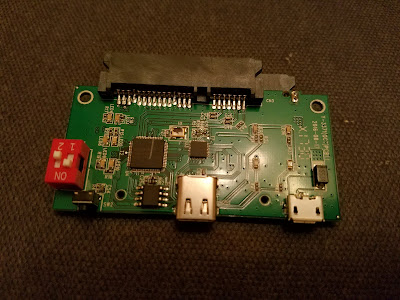NOTE: Inateck provided a 10% coupon code for my blog readers! Code is at the bottom of the page.
I recently received an Inateck 2.5" HD RAID enclosure ( model FE2101 ) for a product review. Here is what came with the product:
- FE2101 Enclosure
- USB-A to USB-C Cable
- USB-C to USB-C Cable
- Screwdriver and 4 HD screws
- Instruction Manual
 |
| FE2101 Enclosure |
 |
| Reset Button / USB-C / microUSB for power (optional) |
 |
| USB cables Plastic bag: 4 HD screws and a screwdriver |
 |
| Little optional stand you can put under the enclosure |
NO-RAID: Basically you see the two independent drives as if you had two external cases/drives.
JBOD: Shows up as one large drive.
RAID0: The data is striped across the two drives, which should give a performance boost but a failure of either drive would cause data loss.
RAID1: The data is mirrored on both drives.
This is important. The drive supports a maximum height of 8mm HDD/SDD drives. So make sure your drives are compatible. The two 7200RPM 160GB drives I had for testing were not compatible, so I had to get a bit creative. Long story short, I removed the circuit board from the enclosure assembly and was able to do my testing that way.
 |
| Try slides out of the enclosure |
 |
| Other side of the tray |
 |
| Removed 2 screws to see the internals |
 |
| This is where the magic happens |
- NO-RAID mode performance was similar to the speeds I saw with my Inateck FD2002 HD dock.
- JBOD mode showed up as a 320GB drive, and had similar numbers as the NO-RAID mode which makes sense because JBOD just seems to write the data sequentially on one drive then another.
- RAID0 mode showed up as a 320GB drive, but there was a definite increase in performance. For example, it went from an average of around 65 MB/sec to 126 MB/sec basically doubling the performance. The burst rate also increased but not as much.
- RAID1 mode showed up as a 160GB drive, and showed no real performance difference from the NO-RAID mode. I did not expect performance increase here, but it was nice to see that there was no major decrease either.
One interesting thing I noticed is that the drive hardware (in Windows) has "ASM1352R" in the name, so at least my unit seems to be using the ASMedia ASM1352R host controller. I also noticed the name would be different depending on the mode, for example RAID0 showed "ASM1352R-Fast" while RAID1 showed "ASM1352R-Safe".
For now I am going to keep the drive in RAID1 mode and keep playing around with it. While I do NOT recommend you do this, I was able to cut the plastic tray and get my drives to fit. I almost had to shove it into the enclosure so I would not recommend you do this as the unit was only designed to handle 8mm (maximum) drives.
Update: I decided to test the RAID-1 (mirror) mode to see how it would react to a drive failure. Here is how I tested:
- Started with two drives (160GB and 320GB) and installed Ubuntu.
- Removed 320GB drive from Disc 2 slot, simulating complete drive failure
- Disk 2 blue light stopped blinking, error light went solid red
- Ubuntu did not crash, it kept running fine
- Inserted another 160GB drive into Disk 2 slot
- Both blue lights begin to slowly pulse, red error light is still solid in Disk 2. I think the RAID array is rebuilding itself at this point
- After a while the red error light goes off, the RAID rebuild is done. I didn't time it.
I know this doesn't exactly simulate a real world failure since the drive would likely still work but have bad sectors, but it was still fun to try.
Modes: Offers 4 modes to handle a variety of use case scenarios, but most users will probably use one of the two RAID modes.
Setup: Other than my issue with drive size (keep it under 8mm) the setup was VERY simple, just install the two drives and follow the directions on how to configure the unit. Make sure you do not have data you need on the drives since it will need to be formatted.
Design: The case is small, and in addition to the USB-C port it has a standard microUSB port for power in case your USB port on the computer can't provide enough power. The case itself looks nice, and comes with a little stand you can mount under it if you want.
Bottom line: Nice HD enclosure that supports two drives, and can support RAID 0 and RAID 1.
NOTE: Inateck provided a 10% coupon code for my blog readers! Use the code "FE10OFF" on https://www.inateck.com/
Inateck Product Page: https://www.inateck.com/hard-drive-accessories/hdd-enclosures/inateck-fe2101-dark-gray.html
No comments:
Post a Comment